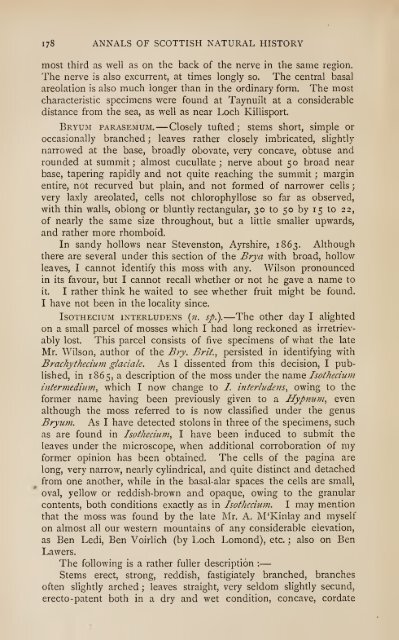Create successful ePaper yourself
Turn your PDF publications into a flip-book with our unique Google optimized e-Paper software.
178 ANNALS OF SCOTTISH NATURAL HISTORY<br />
most third as well as on the back of the nerve in the same region.<br />
The nerve is also excurrent, at times longly so. The central basal<br />
areolation is also much longer than in the ordinary form. The most<br />
characteristic specimens were found at Taynuilt at a considerable<br />
distance from the sea, as well as near Loch Killisport.<br />
BRYUM PARASEMUM. Closely tufted; stems short, simple or<br />
occasionally branched leaves rather<br />
; closely imbricated, slightly<br />
narrowed at the base, broadly obovate, very concave, obtuse and<br />
rounded at summit; almost cucullate nerve about ; 50 broad near<br />
base, tapering rapidly and not quite reaching the summit ; margin<br />
entire, not recurved but plain, and not formed of narrower cells ;<br />
very laxly areolated, cells not chlorophyllose so far as observed,<br />
with thin walls, oblong or bluntly rectangular, 30 to 50 by 15 to 22,<br />
of nearly the same size throughout, but a little smaller upwards,<br />
and rather more rhomboid.<br />
In sandy hollows near Stevenston, Ayrshire, 1863. Although<br />
there are several under this section of the Brya with broad, hollow<br />
leaves, I cannot identify this moss with any. Wilson pronounced<br />
in its favour, but I cannot recall whether or not he gave a name to<br />
it. I rather think he waited to see whether fruit might<br />
I have not been in the locality since.<br />
be found.<br />
ISOTHECIUM INTERLUDENS (n. sp.}.<br />
The other day I alighted<br />
on a small parcel of mosses which I had long reckoned as irretrievably<br />
lost. This parcel consists of five specimens of what the late<br />
Mr. Wilson, author of the Bry. Brit., persisted in identifying with<br />
Brachythedum gladale. As 1 dissented from this decision, I published,<br />
in 1865, a description of the moss under the name Isothecium<br />
intermedium, which I now change to /. interludens, owing to the<br />
former name having been previously given to a Hypnum, even<br />
although the moss referred to is now classified under the genus<br />
Bryum. As I have detected stolons in three of the specimens, such<br />
as are found in Isothecium, I have been induced to submit the<br />
leaves under the microscope, when additional corroboration of my<br />
former opinion has been obtained. The cells of the pagina are<br />
long, very narrow, nearly cylindrical, and quite distinct and detached<br />
from one another, while in the basal-alar spaces the cells are small,<br />
oval, yellow or reddish-brown and opaque, owing to the granular<br />
contents, both conditions exactly as in Isothecium. I may mention<br />
that the moss was found by the late Mr. A. M'Kinlay and myself<br />
on almost all our western mountains of any considerable elevation,<br />
as Ben Ledi, Ben Voirlich (by Loch Lomond),<br />
etc. : also on Ben<br />
Lawers.<br />
The following<br />
is a rather fuller description<br />
:<br />
Stems erect, strong, reddish, fastigiately branched, branches<br />
often slightly arched ;<br />
leaves straight, very seldom slightly secund,<br />
erecto-patent both in a dry and wet condition, concave, cordate

















